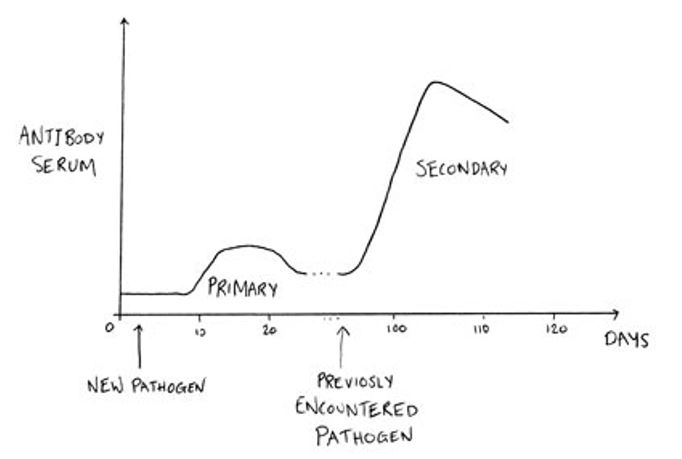Humoral immunity is the arm of the adaptive immune response whose primary function is the elimination of microbial toxins and extracellular microbes. It is worth noting that this form of immunity is primarily mediated by activated B lymphocytes that produce antibodies after undergoing differentiation. The formation of antigen-antibody complex may result in various effecter mechanisms or responses including neutralization of bacterial toxins and viruses, destruction of cells or pathogens, complement activation, opsonization of the antigen, adherence of antigens to immune cells, and agglutination. Two forms of responses take place during the development of humoral immunity: primary and secondary responses (Porth, Carol and Matfin, 2010).
Primary immune response takes place when the pathogen or antigen is introduced into the body for the first time. During this response, there is a lag or latent period before the presence of antibodies in serum can be detected (Sherwood, 2007). This lag or latent period is attributed to the time taken by antigen-presenting cells to process the antigen before its recognition by the helper T cells. After helper T receptors specific for the antigen recognize the antigen in association with class IIMHC molecules, the T lymphocytes become activated and subsequently secrete cytokines to further active as well as direct the immune system. In humoral immunity, primarily mediated by B cells, activated helper T cells stimulate B lymphocytes to proliferate and differentiate into a clone of plasma cells that secrete antibodies. According to Sherwood (2006), this activation process normally takes approximately one to two weeks. Most individuals recover from diseases during the primary response when the concentration of the antibodies nears its peak.
Memory or Secondary response takes place on the subsequent or second exposure to the same antigen. During the first or primary response, a section of activated B cells does not undergo differentiation to form plasma cells but instead form a pool of memory B lymphocytes. During the secondary response, there is a rapid rise in the concentration of antibodies reaching its peak within a very short period due to the presence of memory cells

Natural immunity refers to any immunity that an individual acquires during the normal biological experience of an individual as rather than via medical procedures. Natural active immunity refers to the resistance developed by an organism after recovery from an organism. Natural passive immunity refers to resistance that is acquired as a result of postnatal or prenatal, child-mother relationship. During infancy a certain class of immunoglobulin circulating in the maternal blood may find their to the foetal blood system by crossing the placenta. Another source of natural passive immunity is provided by the antibodies in the maternal milk that finds their way to the baby’s body through breastfeeding (Nath, 2006).
Artificial immunity refers to the protection against infections acquired through medical intervention. This form of immunity is induced through immunization with immune serum or vaccines. Artificial active immunity also referred to as vaccination results in an organism receiving a dosage of a given antigen to prevent infection via stimulation of antibodies against a specific antigen. Artificial passive immunity results from injection with immunoglobulin from another individual (Day, 2007).
Monoclonal antibodies are vital reagents employed in the treatment of medical complications like cancer, diagnosis of illnesses and biomedical research. These antibodies are produced by clones of B cells obtained from animals that have been vaccinated with an antigen-specific for the desired antibody.
An antigen is commonly defined as any substance that if foreign to an organism’s body, has the ability to induce the secretion of antibodies specific to its epitope. In case such a substance is introduced into the vertebrate host, like a rat or mouse through injection, some of the organism’s B cells will undergo differentiation into plasma cells and start secreting antibodies specific for the foreign substance. According to Cheresh (2007), each antigen-specific B lymphocyte secretes an inimitable antibody characterized by Ig gene rearrangements and affinity maturation (colonial selection). Hence, during an immune response, numerous varying antibodies are secreted that recognize various epitopes of the antigen. The natural assortment of antibodies present in serum is referred to as polyclonal antibodies as it results from different clones of B plasma cells. Unlike polyclonal antibodies, monoclonal antibodies are produced by clones of a given B cell line.
The principle behind monoclonal antibody production technology is the 1975 discovery by Milstein and Kohler that it was possible to produce an immortalized hybridoma cell with both the ability to produce a specific antibody. The procedure involves the fusion of myeloma cell lines that have lost their ability to secrete antibodies with healthy B cells producing a given antibody. The resulting cell line has both the ability to produce specific antibodies ( a characteristic inherited from their healthy parent B cells) as well as rapid and continuous growth and division since they are cancerous ( characteristic ) obtained from their myeloma parent. The immortality inherited from their myeloma parent enables them to survive in a culture where normal cells can survive. The healthy B cells are obtained by injecting a mouse with an antigen against a specific antibody (Cheresh, 2007)
References
Cheresh, D. A. (2007). Integrins. London: Elsevier Inc.
Day, M. J. (2007). Introduction to Immunology. New York: Macmillan Publishers. Immune System. (2010). Web.
Nath, J. L. (2006). Using Medical Terminology: a practical approach. Philadelphia, PA: Lippincott Williams & Wilkins.
Porth, Carol M. And Matfin, G. (2010). Essentials of pathophysiology: concepts of altered health states. New York, NY: Wolter Kluwer.
Sherwood, L. (2006). Fundamentals of physiology: a human perspective. Belmont, CA: Thomson Books
Sherwood, L. (2007). Human Physiology: From Cells to Systems. Belmont, CA: Cengage Learning.